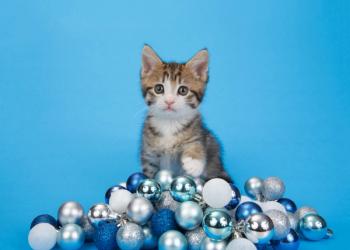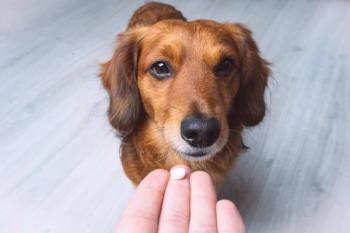
- December 2016
- Volume 1
- Issue 3
Canine Socialization: More Than Meets the Eye
The importance of early environmental exposure for puppies has been recognized since the early 1960s. However, not all exposure is the same and proper implementation takes thoughtful preparation and planning.
The importance of early environmental exposure for puppies has been recognized since the early 1960s.1,2 However, not all exposure is the same and proper implementation takes thoughtful preparation and planning. When most people think about socialization, they might think about letting their dog play with other dogs. Yet, there is more to it than a romp in the park. The broader meaning of socialization incorporates localization.
• Socialization is the process of learning to communicate and relate with humans, members of the same species, and other animals.
• Localization is the process of learning to be attached to specific environments.
Animals tend to be the most comfortable with environments to which they were exposed at a young age. Socialization and localization include exposure to various environments, sounds, people, animals, and novelty. Both socialization and localization shape future behavioral responses and they prepare dogs for the myriad of social and environmental experiences thrown at them later in life.
When Should Socialization and Localization Occur?
The socialization period occurs between 3 and 12 weeks of age and it is a sensitive period for the development of long-lasting social attachments and foundation memories.3 It may be considered as the most influential learning period for a dog with regards to living within the domestic human household. It is much more difficult to socialize a puppy after 3 months of age without early positive foundation memories.4 However, socialization and exposure are part of a lifelong process. As a puppy comes out of its socialization period and becomes more suspicious of novelty, controlled and positive exposure is probably equally important. If a puppy owner were to stop socializing a puppy at 3 months of age, the puppy would be more likely to become fearful as an adolescent. Even the well-socialized dog might regress if positive exposure does not continue into adolescence. After the socialization period is over, strive for at least 3 to 4 novel and/or repeated positive experiences a week. This can easily occur while out on a daily walk in the neighborhood.
A dog who is obtained after the socialization period is over, with an unknown or suspected lack of early positive experiences, can benefit from exposure if the dog is relaxed and having fun during the experiences.
How is Positive Proactive Exposure Implemented?
A common mistake that well-meaning people make is to rely solely on habituation when introducing a puppy or adult dog to novel experiences.
• Habituation is the process of acclimating or becoming familiar and comfortable with stimuli through repeated exposure. It is the decreasing of a response to a stimulus.
Yet, socialization is not just about exposure and habituation. The problem is that habituation does not focus on creating pleasant associations, rather it focuses simply on repeated exposure. Puppies may easily become overwhelmed and sensitized to environmental stimuli, especially if there are negative associations with the first experience. It is difficult to habituate to experiences that produce strong negative emotional responses. Dogs don’t readily habituate to scary situations. Instead, undesirable flight or fight responses become ingrained. Socialization is not simply about habituation; it is first and foremost about making exposure pleasant and fun.
Positive proactive exposure (PPE) is an active process that involves classical conditioning, classical counter-conditioning, and desensitization.
• Classical conditioning is the process of replacing a neutral emotional response to a stimulus with, in this case, a positive emotional response. Pleasant emotional responses in puppies can be easily conditioned by using food rewards.
• Classical counter-conditioning is the process of replaying a negative emotional response to a stimulus with a positive emotional response. Negative emotional responses can often be changed by using food rewards.
• Desensitization is the process of reducing sensitivity or reactivity toward stimuli through gradual and controlled exposure.
Although desensitization and counter-conditioning techniques are often used retroactively to treat existing fears or aversions, it is important to apply these techniques proactively to help prevent fearful associations. During PPE, food rewards are used extensively and overwhelming situations are avoided. Prevention is the key: it is much better to be proactive rather than reactive. PPE fosters pleasant emotions with the first introduction or exposure to stimuli.
Implementing Positive Proactive Exposure (PPE):
• Bring a hungry puppy with a proper fitting collar or harness and a 4-6-foot leash.
• Take a variety of pea-sized “puppy-approved” treats and a favorite toy. Include water and bowl for extended trips.
• Stay clear of the "action" when first arriving and observe from a non-stressful distance before reducing the dis- tance. Allow the puppy to acclimate at its own pace.
• Be proactive; assume the puppy could potentially be afraid of a new person, object, or environment and use treats liberally.
• Control the environment and what the puppy learns; keep experiences positive.
• Be aware of body language and recognize signs of fear, anxiety, or stress (FAS). Be your puppy’s advocate. Do not wait for signs of fear before initiating food rewards.
• Keep sessions short and positive; 5 to 10 minutes is often enough. Avoid going over 30 minutes unless the puppy can have a reprieve. Sessions can be gradually lengthened.
• Measure out the amount of treats the puppy will be fed and end the session before running out.
• Have fun!
What to Do If the Puppy Becomes Frightened
Utilize the behavior modification techniques, classical counter-conditioning and desensitization. These techniques were utilized with PPE. Here, the techniques are implemented in reaction to fear inducing stimuli.
Food treats are paired with the sight of or reaction to fear evoking stimuli. Food changes the emotional response from an unpleasant to a pleasant emotion.
Gradual exposure is accomplished by controlling the distance and intensity of the stimulus. In general, the farther away from the stimulus, the less frightening.
If frightened:
• Use food rewards liberally to change the emotional state
• Get the puppy out of the situation and find a non-stressful starting point for exposure
• Allow the puppy to investigate novelty at his own pace
• Reinforce exploration with food rewards and movement away from the stimulus
• Avoid coddling or reprimanding. Dramatic changes in your behavior may become predictive of fear eliciting stimuli and they may worsen the fear response. Remain relaxed and neutral. Let the treats do the talking!
• Utilize PPE with future exposure... Rather than a neutral experience or, even worse, an overwhelmingly negative experience, new and repeated experiences are made positive from the start.
Summary
PPE involves planning ahead and preparing to make associations positive. Anticipate that first-time and repeated experiences may be scary for puppy and human alike. Socialization and exposure are only valuable if they are enjoyable for the puppy. Taking a positive proactive approach from the start will prevent the need to do “rehabilitation” later.
References:
- Freedman DG, King JA, Elliot O. 1961. Critical periods in the social development of the dog. Science, 133, 1016-1017.
- Scott JP. 1963. The primary socialization in canine and human infants. Society for Research in Child Development Monographs, 28, 1-47.
- Scott JP, Fuller JL. Dog Behavior: The Genetic Basis. Chicago: University of Chicago Press, 1974;84-141.
- Serpell J, Jagoe JA. Early experience and the development of behaviour. In Serpell J (ed). The Domestic Dog, p.82-102, Cambridge University Press, 1995.
Articles in this issue
almost 9 years ago
Three Ways Client Service Representatives Can Build Client Loyaltyalmost 9 years ago
The Use of Hyperbaric Oxygen Therapy in Small Animal Medicinealmost 9 years ago
Trained Therapy Animals Boost the Moods of Cancer Patientsalmost 9 years ago
Changes in 2016 Set the Stage for Exciting 2017almost 9 years ago
Dealing with Fleasalmost 9 years ago
Delinquent Clients: The Price of Compassionate Care?almost 9 years ago
Cranial Cruciate Ligament Injuryalmost 9 years ago
Extractions in the Real Worldalmost 9 years ago
Factors That Adversely Affect Reproductive Success in Maresalmost 9 years ago
Growing Gains, Not PainsNewsletter
From exam room tips to practice management insights, get trusted veterinary news delivered straight to your inbox—subscribe to dvm360.






